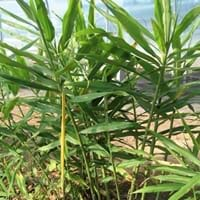Life Span
Perennial
Annual
Type
Shrub
Tender Perennial
Origin
North America, United States, Northeastern United States, Mid-Atlantic United States, Southeastern United States, Canada
Southern Asia, India, China, Melanesia, Micronesia, Australia
Types
Red chokeberry, Purple chokeberry
Not Available
Number of Varieties
Not Available
Habitat
Anthropogenic, Boggy areas, Cliffs, Fens, Swamps, Terrestrial, Wet lands, Woodlands
agricultural areas, Moist Soils, Warmer regions
USDA Hardiness Zone
3-8
Not Available
AHS Heat Zone
8-1
Not Available
Sunset Zone
A2, A3, 1a, 1b, 2a, 2b, 3a, 3b, 4, 5, 6, 7
Not Available
Habit
Thicket/Colonizing
Clump-Forming
Flower Color
Not Available
White, Red, Green, Orange, Pink, Magenta, Fuchsia, Rose, Lavender
Flower Color Modifier
Not Available
Bicolor
Fruit Color
Purplish-black
Not Available
Leaf Color in Spring
Not Available
Green, Dark Green
Leaf Color in Summer
Not Available
Green, Dark Green
Leaf Color in Fall
Not Available
Green, Dark Green
Leaf Color in Winter
Not Available
Light Green
Leaf Shape
Elliptic
Linear
Plant Season
Spring, Summer, Fall
Not Available
Sunlight
Full Sun, Partial Sun, Partial shade
Partial Sun
Growth Rate
Medium
Medium
Type of Soil
Clay, Loam
Not Available
The pH of Soil
Acidic, Neutral, Alkaline
Not Available
Soil Drainage
Average
Moist
Bloom Time
Late Spring, Early Summer
Indeterminate
Repeat Bloomer
No
Not Available
Tolerances
Not Available
Drought
Where to Plant?
Ground, Pot
Container, Ground
How to Plant?
Cuttings, Divison, Seedlings
From Rhizomes
Plant Maintenance
Medium
Medium
Watering Requirements
Average Water Needs, Do Not over Water, Requires regular watering
Do Not over Water, Keep ground moist
In Summer
Lots of watering
Adequately
In Spring
Moderate
Moderate
In Winter
Average Water
Less Watering
Soil pH
Acidic, Neutral, Alkaline
Not Available
Soil Type
Clay, Loam
Not Available
Soil Drainage Capacity
Average
Not Available
Sun Exposure
Full Sun, Partial Sun, Partial shade
Partial Sun
Pruning
Prune after flowering, Remove branches that rub together, Remove damaged leaves, Remove dead branches, Remove dead leaves, Remove diseased branches by the tool's blades dipped into the alcohol solution
Remove damaged leaves, Remove dead branches, Remove dead leaves
Fertilizers
10-10-10, All-Purpose Liquid Fertilizer, Apply N-P-K
All-Purpose Liquid Fertilizer
Pests and Diseases
Red blotch
Bacteria wilt, Bacterial Blight, Rhizome rot, Root knot nematode
Plant Tolerance
Not Available
Drought
Flower Petal Number
Not Available
Single
Fragrant Fruit
No
Not Available
Fragrant Leaf
No
Not Available
Fragrant Bark/Stem
No
Not Available
Foliage Texture
Not Available
Not Available
Foliage Sheen
Not Available
Not Available
Self-Sowing
No
Not Available
Attracts
Not Available
Butterflies, Flying insects
Allergy
Anaphylaxis
Heartburn, Stomach burn
Aesthetic Uses
Showy Purposes
Beautification, Ground Cover
Beauty Benefits
Good for skin
Acne, For treating wrinkles, Nourishes scalp, Speed hair growth
Environmental Uses
Air purification, Food for birds, Wildlife
Indoor Air Purification, Provides ground cover, soil stabilisation
Medicinal Uses
anti-cancer, Antioxidants, Cold
Cold, Dysentry, High cholestrol, Rheumatoid arthritis, Skin Disorders, Treat Parasitic Intestinal Worms, Weight management and satiety
Part of Plant Used
Fruits
Leaves, Rhizomes
Other Uses
Pectin
Can be made into a herbal tea, Cosmetics, Oil is used in perfume, soaps, creams, etc., Used as Ornamental plant, Used as a spice
Used As Indoor Plant
No
Yes
Used As Outdoor Plant
Yes
Yes
Garden Design
Foundation, Mixed Border
Container, Cutflower, Houseplant, Tropical
Botanical Name
ARONIA melanocarpa
CURCUMA
Common Name
Black Chokeberry
Ginger
In Hindi
Black Chokeberry Shrub
अदरक
In German
Schwarz Aronia Strauch
Ingwer
In French
Noir Chokeberry Arbuste
Gingembre
In Spanish
Chokeberry negro Arbusto
Jengibre
In Greek
Μαύρο Chokeberry θάμνων
Τζίντζερ
In Portuguese
Chokeberry preto Arbusto
Gengibre
In Polish
Krzew aronii
Imbir
In Latin
Lichen Frutex
gingiber
Phylum
Magnoliophyta
Magnoliophyta
Class
Magnoliopsida
Liliopsida
Order
Rosales
Zingiberales
Family
Rosaceae
Zingiberaceae
Genus
Aronia
Zingiber Mill.
Clade
Angiosperms, Eudicots, Rosids
Angiosperms, Commelinids, Monocots
Tribe
Maleae
Not Available
Subfamily
Amygdaloideae
Not Available
Number of Species
Not Available
Not Available
Season and Care of Black Chokeberry and Ginger Plant
Season and care of Black Chokeberry and Ginger Plant is important to know. While considering everything about Black Chokeberry and Ginger Plant Care, growing season is an essential factor. Black Chokeberry season is Spring, Summer and Fall and Ginger Plant season is Spring, Summer and Fall. The type of soil for Black Chokeberry is Clay, Loam and for Ginger Plant is Not Available while the PH of soil for Black Chokeberry is Acidic, Neutral, Alkaline and for Ginger Plant is Not Available.
Black Chokeberry and Ginger Plant Physical Information
Black Chokeberry and Ginger Plant physical information is very important for comparison. Black Chokeberry height is 182.88 cm and width 182.88 cm whereas Ginger Plant height is 200.00 cm and width 1,500.00 cm. The color specification of Black Chokeberry and Ginger Plant are as follows:
Black Chokeberry flower color: Not Available
Black Chokeberry leaf color: Not Available
Ginger Plant flower color: White, Red, Green, Orange, Pink, Magenta, Fuchsia, Rose and Lavender
- Ginger Plant leaf color: Green and Dark Green
Care of Black Chokeberry and Ginger Plant
Care of Black Chokeberry and Ginger Plant include pruning, fertilizers, watering etc. Black Chokeberry pruning is done Prune after flowering, Remove branches that rub together, Remove damaged leaves, Remove dead branches, Remove dead leaves and Remove diseased branches by the tool's blades dipped into the alcohol solution and Ginger Plant pruning is done Remove damaged leaves, Remove dead branches and Remove dead leaves. In summer Black Chokeberry needs Lots of watering and in winter, it needs Average Water. Whereas, in summer Ginger Plant needs Adequately and in winter, it needs Less Watering.





